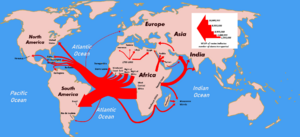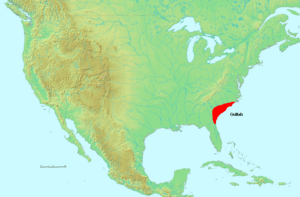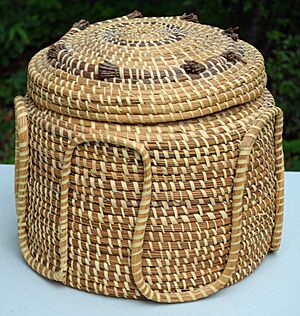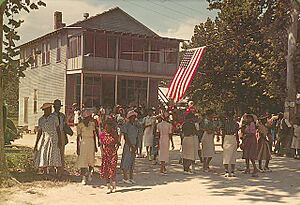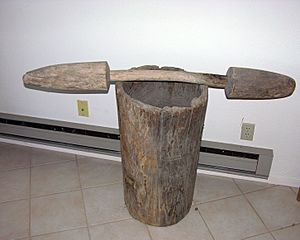Gullah facts for kids
| Gullah Geechee | |
|---|---|
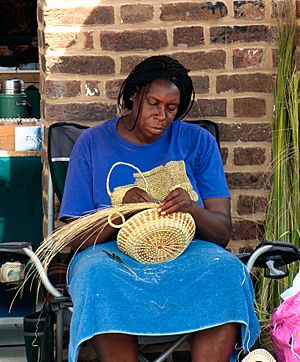
A Gullah woman makes a sweetgrass basket in Charleston's City Market.
|
|
| Total population | |
| Est. 200,000 | |
| Regions with significant populations | |
| North Carolina • South Carolina • Georgia • Florida • Liberia | |
| Languages | |
| English (American English, African-American English) Gullah |
|
| Religion | |
| Majority Protestant; minorities Roman Catholic and Hoodoo | |
| Related ethnic groups | |
| African Americans, Afro-Bahamians, Afro-Trinidadians, Haitians, West Africans, Black Seminoles |
The Gullah people are a special group of African Americans. They mostly live in the Lowcountry region. This area includes coastal parts of North Carolina, South Carolina, Georgia, and Florida. They also live on the Sea Islands along the coast.
The Gullah have kept many parts of their African heritage alive. This is because they lived in a somewhat isolated area for a long time. Their unique language and culture show strong influences from Africa.
Historically, the Gullah region stretched from Cape Fear in North Carolina. It went south to Jacksonville in Florida. The Gullah people and their language are also called Geechee. This name might come from the Ogeechee River in Georgia.
The word Gullah first described their special English dialect. Over time, it became the name for their language and their distinct identity. Gullah communities in Georgia are called "Freshwater Geechee" or "Saltwater Geechee." This depends on if they live on the mainland or the Sea Islands.
People forced into slavery from Central and West Africa developed a unique culture. They lived on large plantations in rural areas. This culture kept many African language and traditions. They also blended in new influences from their new home. Many Gullah/Geechees also have some Native American heritage.
The Gullah speak an English-based creole language. It has many words from African languages. Its grammar and sentence structure are also influenced by African languages. This language is sometimes called "Sea Island Creole." It is similar to other creole languages like Jamaican Patois and Sierra Leone Krio.
Gullah traditions show strong ties to Central and West African cultures. These include their crafts, farming, fishing, beliefs, music, and rice-based cooking. Their storytelling is also very unique.
Contents
Where Did the Names "Gullah" and "Geechee" Come From?
Understanding the Name "Gullah"
The word Gullah might come from the Kikongo language. This language is spoken near the Congo River in Africa. Many Gullah ancestors came from a country called Angola. Records show that many people brought to the Port of Charleston were from Angola. The story of Gullah Jack, a person from Angola, also supports this idea.
Another idea is that Gullah comes from the Gola people. They are an ethnic group in West Africa, near Sierra Leone and Liberia. This area was known as the "Grain Coast" or "Rice Coast." Many people from this region were forced into slavery.
Some also think the name might be linked to the Dyula people. They were a large group in West Africa. The word "Dyula" sounds like "Gwullah" to some people.
Understanding the Name "Geechee"
The name "Geechee" is another common name for the Gullah people. It might come from the Kissi people, who live in West Africa. They are from areas near Sierra Leone, Guinea, and Liberia.
Another idea is that "Geechee" comes from the Ogeechee River in Georgia. Sapelo Island, a Gullah community, was a safe place for people escaping slavery.
The History of the Gullah People
Where Gullah Ancestors Came From
Many Gullah ancestors were people forced into slavery from West and Central Africa. Records from the Port of Charleston show where these people came from. Large numbers arrived from Angola, Senegambia, and the Windward Coast.
People in West Africa had grown African rice for thousands of years. This rice was different from Asian rice. When planters in the American South found that African rice grew well there, they sought out people from rice-growing regions. These enslaved Africans had important skills. They knew how to build irrigation systems and manage water for rice fields.
Bunce Island in the Sierra Leone River was a major place for the slave trade. Many enslaved Africans were taken from here to South Carolina and Georgia. Other similar places in Ghana sent people to the Caribbean islands.
Later, in the late 1700s, Freetown, Sierra Leone, was founded. It was a colony for Black people who were free. In 1808, both Great Britain and the United States stopped the African slave trade. The British navy helped free people from slave ships. These freed people were sometimes settled in Sierra Leone. Americans also helped establish Liberia for freed slaves. Some free Black people from the U.S. moved there to build their own society.
How Gullah Culture Developed
The Gullah people kept much of their African heritage. This was due to the climate, geography, and their strong cultural pride. Many different African groups contributed to Gullah culture. These included the Bakongo, Mandinka, Mende, and Wolof.
By the mid-1700s, large areas in Georgia and South Carolina became rice fields. African farmers from the "Rice Coast" brought their skills. They knew how to grow rice and use tidal irrigation. This made rice farming a very successful business.
The warm, wet climate of the Lowcountry brought diseases like malaria and yellow fever. Mosquitoes spread these illnesses. Many Africans had some natural protection against these diseases. European settlers, however, were more affected.
Because of the diseases, many white plantation owners left the Lowcountry. They moved to cities like Charleston during the warmer months. They left African or European overseers in charge of the rice plantations. These plantations had many workers, and African traditions stayed strong.
Over time, the Gullah developed a unique culture. They kept many African languages, customs, and community ways. Their culture was different from other African Americans in other states. In those places, enslaved people lived in smaller groups and had more contact with white culture.
Recently, in late 2024, scientists used sonar technology. They found 45 hidden irrigation systems on Eagles Island, North Carolina. These systems were built by the Gullah Geechee people. They show the amazing engineering skills used for rice farming.
The Civil War and Beyond
When the American Civil War started, Union forces blocked shipping for the Confederate States of America. White plantation owners on the Sea Islands left their homes. They feared an invasion and fled to the mainland.
In 1861, Union forces arrived on the Sea Islands. They found the Gullah people ready for freedom and eager to defend it. Many Gullah people bravely served in the Union Army. The Sea Islands were the first place in the South where enslaved people became free.
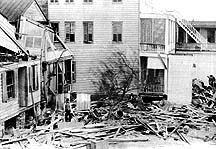
After the war, the Gullah became even more isolated. Rice plantations on the mainland were slowly abandoned. This was due to labor problems and hurricane damage. Free Black people did not want to work in the dangerous rice fields. A series of hurricanes in the 1890s destroyed crops.
Left alone in remote areas, the Gullah continued their traditional culture. They had little outside influence well into the 1900s.
Gullah Culture Today
Since the late 1900s, new resorts have been built on the Sea Islands. This has made property values go up. The Gullah people, led by groups like Penn Center, have fought to keep their family lands. They have used community action, courts, and politics to protect their homes.
The Gullah have also worked to preserve their culture. They faced more contact with modern media and lifestyles. In 1979, work began to translate the New Testament into the Gullah language. The American Bible Society published De Nyew Testament in 2005. Recordings of the Gullah Bible have helped people learn the language.
In 2006, the U.S. Congress passed the "Gullah/Geechee Cultural Heritage Corridor Act." This law set aside money to preserve Gullah historic sites. It created a Heritage Corridor from North Carolina to Florida. The National Park Service works with the Gullah community on this project.
The Gullah have also reconnected with West Africa. Gullah groups made three special "homecomings" to Sierra Leone. These trips happened in 1989, 1997, and 2005. Sierra Leone is where many Gullah ancestors came from. These trips were shown in documentary films.
Gullah Customs and Traditions

African Influences in Gullah Culture
Many Gullah traditions show strong links to African cultures:
- The Gullah word guba (or goober) for peanut comes from the Kikongo and Kimbundu languages.
- Gullah dishes like red rice and okra soup are similar to West African jollof rice and okra soup.
- The Gullah version of "gumbo" has roots in African cooking. "Gumbo" comes from an Angolan word for okra.
- Gullah rice farmers used tools like mortar and pestles and winnowing fanners. These were similar to tools used by West African rice farmers.
- Gullah beliefs about "hags" and "haunts" are like African beliefs about spirits.
- Gullah "root doctors" use special objects to protect people. This is similar to African traditional healers.
- Gullah herbal medicines are like traditional African remedies.
- The Gullah "seekin" ritual is similar to coming of age ceremonies in West Africa.
- The Gullah ring shout is like religious rituals in West and Central Africa.
- Gullah stories about "Br'er Rabbit" are similar to African trickster tales.
- Gullah spirituals and music use a "call and response" method. This is common in African music.
- Gullah "sweetgrass baskets" are woven like traditional baskets from the Wolof people in Senegal.
- Gullah "strip quilts" look like cloth woven on traditional strip looms in West Africa.
- An African song kept by a Gullah family was identified as a Mende funeral hymn from Sierra Leone. This was a major discovery.
- Some Gullah words come from other African languages like Yoruba and Mende.
- The Gullah language is very similar to Sierra Leone Krio. They share words like bigyai ("greedy") and swit ("delicious").
Gullah Cuisine

The Gullah have kept many West African food traditions. They grow and eat crops like Sea Island red peas, Carolina Gold rice, and watermelon. These foods were brought from West Africa.
Rice is a very important food in Gullah communities. It is still grown a lot in coastal Georgia and South Carolina. For the Gullah, a meal is not complete without rice. They have special ways of preparing rice. They carefully clean it and cook it so it steams perfectly. These methods have been passed down for generations.
In 2022, Emily Meggett, an 89-year-old Gullah cook, published a famous book on Gullah cooking.
Celebrating Gullah Culture
Many historians and experts have studied the Gullah. They are interested in their rich cultural heritage. The Gullah have become a symbol of cultural pride for Black people across the United States. Many books, films, and articles have been made about Gullah culture. In 1991, Julie Dash directed Daughters of the Dust. It was the first feature film about the Gullah.
Gullah people now organize cultural festivals every year. Hilton Head Island hosts a "Gullah Celebration" in February. It includes art shows, traditional breakfasts, and film festivals. Beaufort hosts "The Original Gullah Festival" in May. The Penn Center on St. Helena Island holds "Heritage Days" in November. Other festivals happen on James Island, South Carolina, and Sapelo Island, Georgia.
Gullah culture is also celebrated in other parts of the United States. The High Art Museum in Atlanta has shown exhibits about Gullah culture. Purdue University and Metro State College have also hosted events to showcase Gullah traditions.
Cultural Survival
Gullah culture is very strong and has lasted a long time. Gullah traditions are alive in rural areas and on the Sea Islands. They are also strong among Gullah people in cities like Charleston and Savannah.
Many Gullah people moved to cities like New York during the Great Migration. They have kept their traditions alive there. They often send their children back to the Lowcountry in the summer. Many Gullah people return to the Lowcountry when they retire.
The Gullah custom of painting porch ceilings haint blue to keep away spirits still exists. This tradition has also been adopted by other people in the American South.
Representation in Art, Entertainment, and Media
Gullah Gullah Island was a children's TV show on Nickelodeon. It aired from 1994 to 1998. The show was hosted by Ron Daise and his wife Natalie Daise. They were inspired by the Gullah culture of Ron Daise's home, St. Helena Island.
Notable Americans with Gullah Roots
- Robert Sengstacke Abbott, attorney and publisher
- Cornelia Walker Bailey, writer
- Jim Brown, athlete and actor
- Kardea Brown, cook
- Kwame Brown, athlete
- Marion Brown, musician
- Craig Anthony Bullock, musician
- Emory Campbell, community leader
- Septima Poinsette Clark, teacher and activist
- Julie Dash, filmmaker
- Sam Doyle, artist
- William Jonathan Drayton Jr. (Flavor Flav), musician
- Edda L. Fields-Black, historian
- Joe Frazier, athlete
- Candice Glover, singer and performer
- Marquetta Goodwine, activist
- Gullah Jack, religious leader
- Mary Jackson, artist
- James Jamerson, musician
- Griffin Lotson, historian
- Earl Manigault, athlete
- Lenard Larry McKelvey (Charlamagne Tha God), radio host
- Khris Middleton, athlete
- Eric Milligan (The Blixunami)
- Michelle Obama, attorney and First Lady
- Joseph Rainey, politician
- Philip Reid, artist
- Sallie Ann Robinson, cook and author
- Chris Rock, actor and comedian
- Tony Rock, actor and comedian
- Eden Royce, author
- Raven Saunders, athlete
- Philip Simmons, artist
- Robert Smalls, politician
- Vertamae Smart-Grosvenor, anthropologist
- Eddie Sweat, horse racing
- Clarence Thomas, attorney and U.S. Supeme Court justice
- Denmark Vesey, activist
- Kemba Walker, athlete
- Robert Lee Watt, musician
- Maurice Samuel Young (Trick Daddy), musician
See also
- Atlantic Creole
- Bilali Document
- Black Seminoles
- Bristol slave trade
- Coastwise slave trade
- Colonial South and the Chesapeake
- First Africans in Virginia
- Virginia Mixson Geraty
- Ambrose E. Gonzales
- Great Dismal Swamp maroons
- Gullah language
- Igbo Landing
- Joseph Opala
- Port Royal Experiment
- Slavery in the colonial history of the United States
- Stono Rebellion
- Peter H. Wood
- Boo hag
Images for kids


